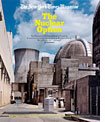 Sunday's edition of the New York Times Magazine will run a cover story on nuclear energy entitled, The Nuclear Option: Why We May See More Reactors Springing Up. Here's a summary we received via email this morning:
Sunday's edition of the New York Times Magazine will run a cover story on nuclear energy entitled, The Nuclear Option: Why We May See More Reactors Springing Up. Here's a summary we received via email this morning:The cover piece looks at the re-emergence of nuclear power plants in America. Cheaper fuel, fewer carbon-emissions fines, and the need to diversify a region's "energy portfolio" are leading to the nuclear route. Foes say nuclear advocates are using global-warming fears to promote dangerous, cost-ineffective projects. Reactor construction is being stalled by astronomical expenses and a years-long application process. But the government is offering "large incentives … to help finance the first few reactors" and the public's old Not-In-My-Backyard fury is giving way to desires for economic growth in small towns, the writer contends. …It's not uncommon for the Times to post these stories online ahead of time, so click here on Saturday if you'd like to get an early look.
Technorati tags: Nuclear Energy, Nuclear Power, Electricity, Environment, Energy, Politics
Comments